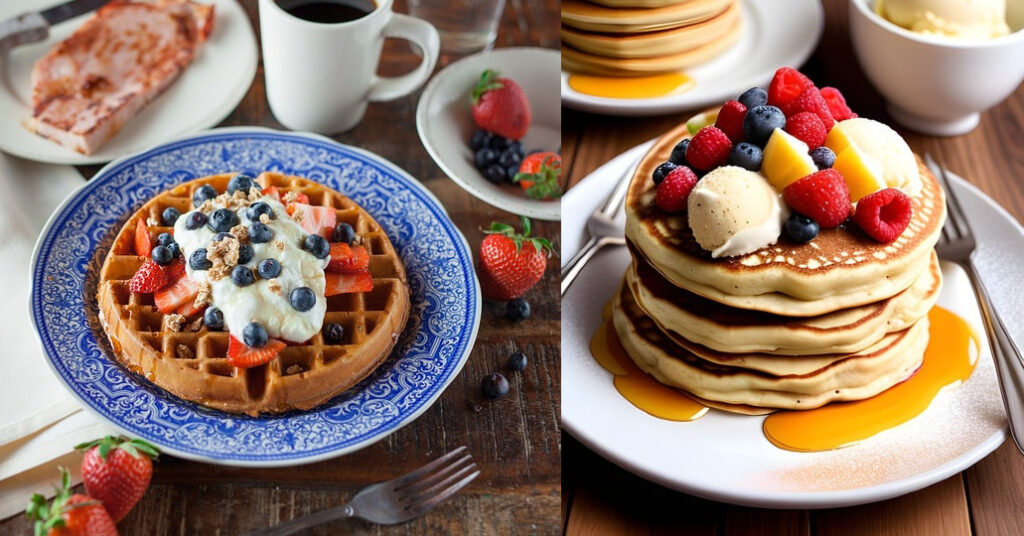Hi! Nice of you to grace us with your presence again, stranger. It’s time to talk about the two pinnacles of breakfast food: waffles and pancakes. Like the famous chicken VS egg debacle, let’s wonder – which came first, waffles or pancakes? Which is tastier? I have to say – I’m just a big fan of fluffy carbs in general. Give me all the pancakes, waffles, crepes, and wafers!
What about you, dear reader: are you a waffle or pancake person? Literally – if you could choose what bready, sugary treat to turn into, which one would you pick? Are you a waffle or a pancake in your heart? Take the quiz and find out at once!

Here’s the question for the members of the waffle fandom. Do you know how old the concept of a waffle is? Ancient Greeks (and their ancestors before them) baked their obleios cakes from batter between red-hot iron plates. These patties were flat and not yet similar to the modern waffle – they were more wafers than traditional waffles, spiceless and thin.
It took until around the 13th century for the waffle irons with a characteristic grid motif to appear; you could also make other shapes, like flowers or stars. The classic batter recipe included flour, water, milk, and sometimes eggs. (Not much changed!) Artisans would decide to spice things up with honey or butter sometimes.
Medieval people from the lowest to the highest classes enjoyed a good waffle treat. Vendors sold waffles on the streets and on religious holidays, took advantage of godly crowds, and set their shop near the church doors. A piping hot waffle after a long mass does sound enticing…
Europe loved their waffles, and the Dutchmen in particular were big waffle enjoyers. The word “waffle” even comes from the Dutch wafel. In the 17th century, the Dutch introduced their favored treat to the American colonies, and what a great success it was. As the legend goes, Thomas Jefferson returned from his European travels with a waffle iron. Thus the glorious and exciting era of the New World waffle has begun.
Americans did two crucial things to waffles: one, they added the letter to the word wafel (creating a “waffle”), and two, they decided to eat waffles with molasses or maple syrup. By the 18th century, waffles became a sought-after breakfast food, and at the end of it, a truly decadent snack as sugar and spices became cheaper. Waffle recipes began calling for wine, lemon zest, cardamom, cloves, and even chocolate. Delicious!
The 1930s made cooking homemade waffles easier with the rise of electric waffle irons. About twenty years later, even the most hopeless cooks rejoiced when frozen waffles entered the stores. Now anybody could’ve enjoyed a tasty waffle in the privacy of their homes.
How do you prepare your waffles (if you do)? What toppings you can’t go without – whipped cream, maple syrup, fresh strawberries, or a simple powdered sugar? Psst – we have a few tips for those who want to learn to prepare fail-free waffles:
don’t overmix your batter to be too smooth, or your waffles be tough,
too much flour will get you a dry waffle, and too little will make it fall apart, so measure it out,
make sure your waffle maker is hot enough.
What about the pancakes? Did the prehistoric children ask their moms for pancakes for breakfast? It’s possible. For early humanity, pancakes were flat cakes prepared from the starch-based batter. Stone-Age people used a mix of flour (made from cattails and ferns) and water to bake pancakes on a hot rock.
The ancient Romans had a simple recipe for whipping up pancakes: olive oil, flour, and milk, and as the diligent records say, enjoyed them with honey, nuts, cheese, or sesame. These archaic pancakes weren’t that different than those we know today, but they weren’t called that yet. The word “pancake” was first coined in the 15th century.
Pancakes gained the reputation of “the food of the people” throughout history. They couldn’t have been easier to prepare for a busy chief. A simple griddle over fire or coals was all that was needed. For families that couldn’t afford meat or fish, pancakes were a cheap way to fill hungry stomachs. Any farmer had traditional pancake ingredients readily on hand. Pancakes were also terrific for using up food that was threatened by potential spoilage, like milk or eggs – no waste allowed!
For me, a pancake was always a delicate crepe filled with jam, chocolate cream, or white cheese – possibly adorned with powdered sugar and fruits. My first contact with chunky American pancakes was quite a surprise! People of Ethiopia enjoy injera, a type of spongy, pancake-like flatbread traditionally used to scoop up other food. Jewish people eat latkes – potato pancakes meant to celebrate Hannukah. It seems like every culture has its own definition of a pancake, and that’s fantastic!
Crispy waffle or fluffy pancake – what is your choice? Find out where your loyalties lie. Are you a waffle or a pancake at heart? Take the quiz now! Bon appetit!